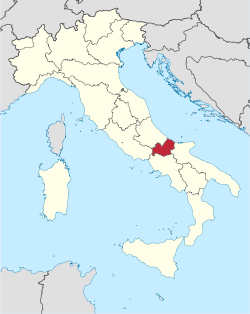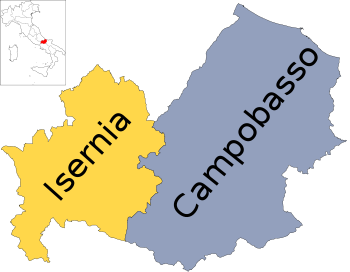- Molise
-
Molise — Region of Italy — 
Flag
Coat of armsCountry Italy Capital Campobasso Government - President Michele Iorio (PdL) Area - Total 4,438 km2 (1,713.5 sq mi) Population (2010-11-30) - Total 319,834 - Density 72.1/km2 (186.7/sq mi) Time zone CET (UTC+1) - Summer (DST) CEST (UTC+2) GDP/ Nominal € 6.5[1] billion (2008) GDP per capita € 20,100[2] (2008) NUTS Region ITF Website www.regione.molise.it Coordinates: 41°41′59″N 14°36′40″E / 41.6997°N 14.6111°E
Molise (pronounced [moˈliːze]) (Molisano: Mulise) is a region of Southern Italy, the second smallest of the regions. It was formerly (until 1963) part of the region of Abruzzi e Molise (with Abruzzo) and now a separate entity. The region covers 4,438 km² and has a population of about 300,000.
Molise is the newest Italian region, since it was established in 1963, when the region Abruzzi e Molise was split in two. It became effective only in 1970.
Contents
Economy
Though there is a large Fiat plant (Termoli), the industrial sector is dominated by the building industry with small and medium-sized farms spread widely throughout the region. Another important industry is food processing: pasta, meat, milk products, oil and wine are the traditional products of the region. In the services sector the most important industries are distribution, hotels and catering, followed by transport and communications, banking and insurance. With few exceptions, in all sectors firms are small, and this explains the difficulties encountered when marketing products on a national scale.[3]
After the earthquake of 2002 some of the communities in Molise became tt policy which contributed state money to individuals willing to make their homes more resistant to seismic activity. Larino, near Termoli, was a particular beneficiary of this policy and the town, already one of the most beautiful in the province, has been transformed. It was policy to return the houses to their historical colours and, based on careful research, the structures were painted in a range of soft pastel tones. As a result Larino has become an important centre for tourism and scores of expatriates from all over the world are returning to live in the revived centro storico (antique centre).
International tourism is becoming more evident largely as a result of the international flights from other European states, Great Britain, and North America which enter Pescara not far to the north in Abruzzo. The tourists are attracted by large expanses of unspoiled beaches, a relative lack of congestion, and the gentle pace of life.
Demographics
Historical populations Year Pop. ±% 1861 355,000 — 1871 374,000 +5.4% 1881 382,000 +2.1% 1901 395,000 +3.4% 1911 396,000 +0.3% 1921 383,000 −3.3% 1931 377,000 −1.6% 1936 388,000 +2.9% 1951 407,000 +4.9% 1961 358,000 −12.0% 1971 320,000 −10.6% 1981 328,000 +2.5% 1991 331,000 +0.9% 2001 321,000 −3.0% 2010 (Est.) 319,000 −0.6% Source: ISTAT 2001 The density of the population in Molise is well below the national average. In 2008, Molise registered 72.3 inhabitants per km2, compared to a national figure of 198.8. The region is subdivided into two provinces: Campobasso and Isernia, covering together 1.5% of the Italian territory and less than 1% of its population. The larger province in terms of surface area is Campobasso (2,909 km2) and the smaller is Isernia (1,529 km2). The province of Campobasso is the more densely populated of the two provinces, with 79.4 inhabitants per km2, whereas Isernia registered 58.9 inhabitants per km2.[4] At the end of 2008 the most populous towns were Campobasso (51,247 inhabitants), Termoli (32,420) and Isernia (21,811).
In the period 1951-71, large-scale emigration to other countries of the European Union, to other parts of Italy and overseas led to a significant decline in the population of Molise. Negative net migration persisted until 1981. Large-scale emigration has caused many of the smaller towns and villages to lose over 60% of their population, while only a small number of larger towns have recorded significant gains. From 1982 to 1994, net migration has been positive, then followed by a negative trend until 2001. Between 1991 (330,900 inhabitants) and 2001 (320,601 inhabitants), the population of the region decreased by 3.1%;[4] since 2001 the population remained stable.
In the region there are two ethnic minorities: the Molisan Croats (5,000 people who speak an old Dalmatian dialect of the Croatian language) and the Molisan Albanians (who speak a divergent variety of Albanian, Arbëresh, very different from the Albanian spoken on the other side of the Adriatic Sea). Molisan Albanians are generally of the Byzantine Catholic religion, while Molise Croats are generally Catholics.
Government and politics
Although the region has a center-right local government, at the April 2006 elections, Molise gave 50.5% of its votes to Romano Prodi of the centre-to-left Olive Tree party. Nonetheless, in November of the same year, Michele Iorio (centre-right candidate), won the regional election with over 54% of votes.
Administrative divisions
Molise comprises two provinces:
Province Area (km²) Population Density (inh./km²) Province of Campobasso 2,909 231,921 79.7 Province of Isernia 1,529 88,931 58.2 International relations
See also: List of twin towns and sister cities in ItalyTwin towns — Sister cities
Molise is twinned with:
See also
- 2002 Molise earthquake
- Ndocciata, a torchlight parade traditionally held in Molise on Christmas Eve
- Molise Croatian dialect
References
- ^ "Eurostat - Tables, Graphs and Maps Interface (TGM) table". Epp.eurostat.ec.europa.eu. 2011-08-12. http://epp.eurostat.ec.europa.eu/tgm/table.do?tab=table&init=1&language=en&pcode=tgs00003&plugin=1. Retrieved 2011-09-16.
- ^ EUROPA - Press Releases - Regional GDP per inhabitant in 2008 GDP per inhabitant ranged from 28% of the EU27 average in Severozapaden in Bulgaria to 343% in Inner London
- ^ "Eurostat". Circa.europa.eu. http://circa.europa.eu/irc/dsis/regportraits/info/data/en/itf2_eco.htm. Retrieved 2009-05-05.
- ^ a b "Eurostat". Circa.europa.eu. 2001-01-01. http://circa.europa.eu/irc/dsis/regportraits/info/data/en/itf2_pop.htm. Retrieved 2009-05-05.
- ^ "Nowy Sącz - Partner Cities". © 2008-2009 Urząd Miasta Nowego Sącza, Rynek 1, 33-300 Nowy Sącz. http://www.nowysacz.pl/?p=1&p2=167&main=inc-miastapar. Retrieved 2009-08-03.
External links
- Official Site of the Regione Molise (Italian)
- Molise Region information site (Italian)
- Images of Molise
 Molise
MoliseProvinces
and places
Politics and
governmentRegions of Italy Categories:- Molise
- Regions of Italy
- States and territories established in 1963
Wikimedia Foundation. 2010.


